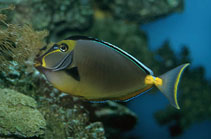| Family: |
Acanthuridae (Surgeonfishes, tangs, unicornfishes), subfamily: Nasinae |
| Max. size: |
46 cm SL (male/unsexed); max.weight: 2,286.0 g |
| Environment: |
reef-associated; marine; depth range 0 - 90 m |
| Distribution: |
East Indian Ocean from Christmas Pacific Ocean: Honshu, Japan south to the Great Barrier Reef and New Caledonia and east to the Hawaiian Islands, French Polynesia, and Pitcairn. Eastern Pacific: Clipperton Island. Once regarded a wide-ranging Indo-Pacific species, the Indian Ocean population is now recognized as a separate species, Naso elegans. |
| Diagnosis: |
Dorsal spines (total): 6-6; Dorsal soft rays (total): 26-29; Anal spines: 2-2; Anal soft rays: 27-30. This species is distinguished by the following characters: D VI (rarely V or VII),26-29(modally 27); A II,27-30 (rarely 27 or 30); pectoral rays usually 17; body depths of adults 2.6-3.0 in SL; head dorsal profile sloping and smoothly convex (forehead no horn nor protuberances); two large peduncular plates, the keels with forward-projecting points in adults; caudal fin emaginate in young and truncate in adults; body brown to bluish gray, ventral half yellowish gray to yellow, the demarcation along middle of side often abrupt and irregular; edge of opercle and preopercle usually with a dark brown band; margin of lower lip broadly white with upper surface of tongue black in adults; gill rakers are blackish basally; blue caudal fin with a broad, brownish yellow, posterior border which narrows toward corners of fin; it is capable of changing overall into light grayish blue, as when at a cleaning station; when in courtship the males quickly display a broad, bluish white zone on the nape and anterior part of the body , followed by narrow bars of the same color that extend onto lower side (Ref. 54980).
Description: Characterized further by yellow forehead; pelvic fins yellow; caudal peduncle with pair of bony plates, each with sharp forward projecting keel; large adult male with prolonged filaments on caudal fin lobes; greatest depth of body 2.2-2.7 in SL (Ref. 90102). |
| Biology: |
Found in areas of coral, rock, or rubble of lagoon and seaward reefs, Ref. 48637. Benthopelagic (Ref. 58302). Adults usually in small groups. Juveniles in shallow rocky reefs, sometimes in small aggregations mixed with other acanthurids of similar size (Ref. 48637). Feed mainly on leafy brown algae (Sargassum and Dictyota). Sometimes in large aggregations (Ref. 37792). Very seldom poisonous (Ref. 4795). Pair-spawning has been observed. |
| IUCN Red List Status: |
Least Concern (LC); Date assessed: 06 May 2010 Ref. (130435)
|
| Threat to humans: |
venomous |
| Country info: |
|
Source and more info: www.fishbase.org. For personal, classroom, and other internal use only. Not for publication.

